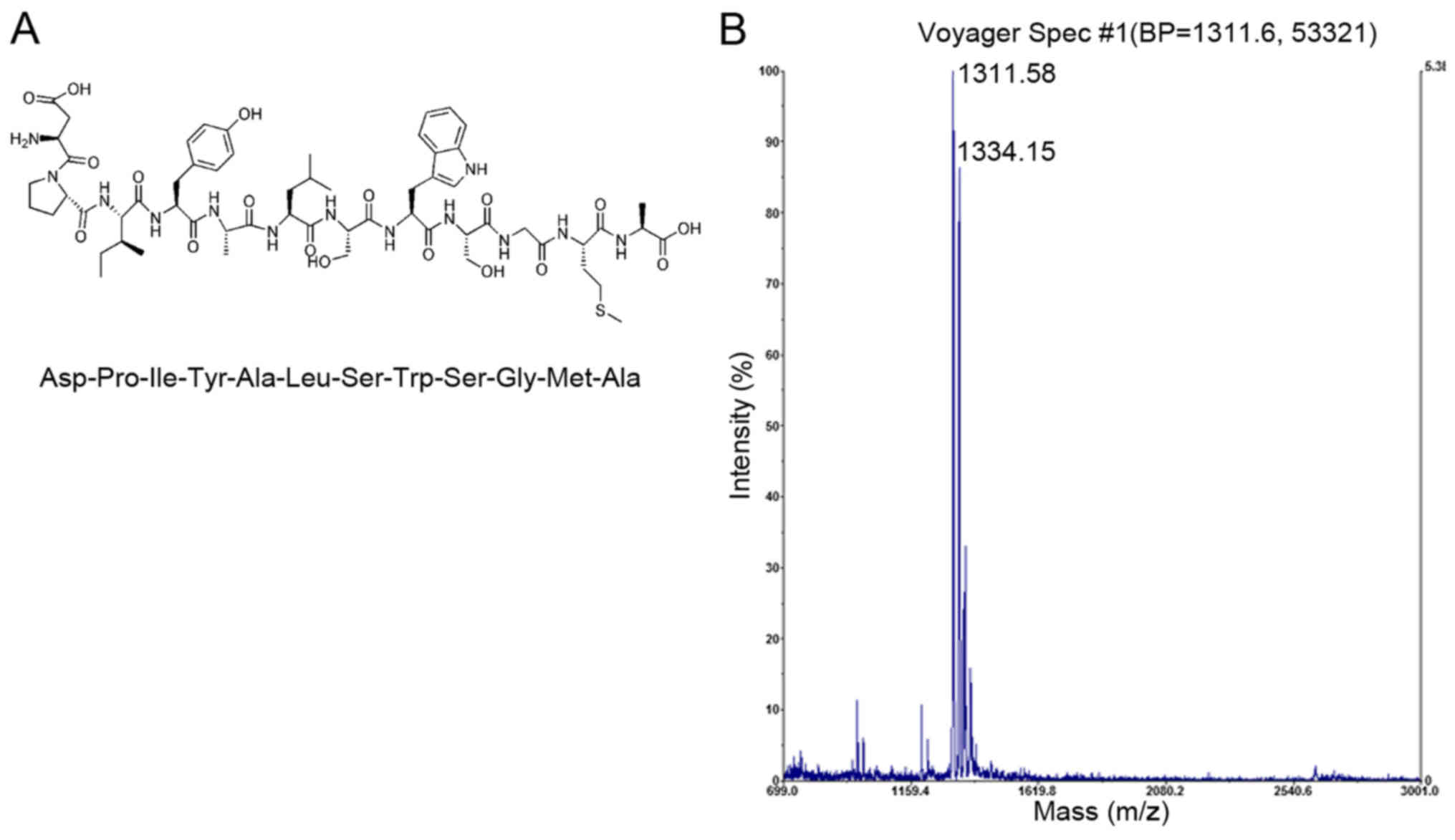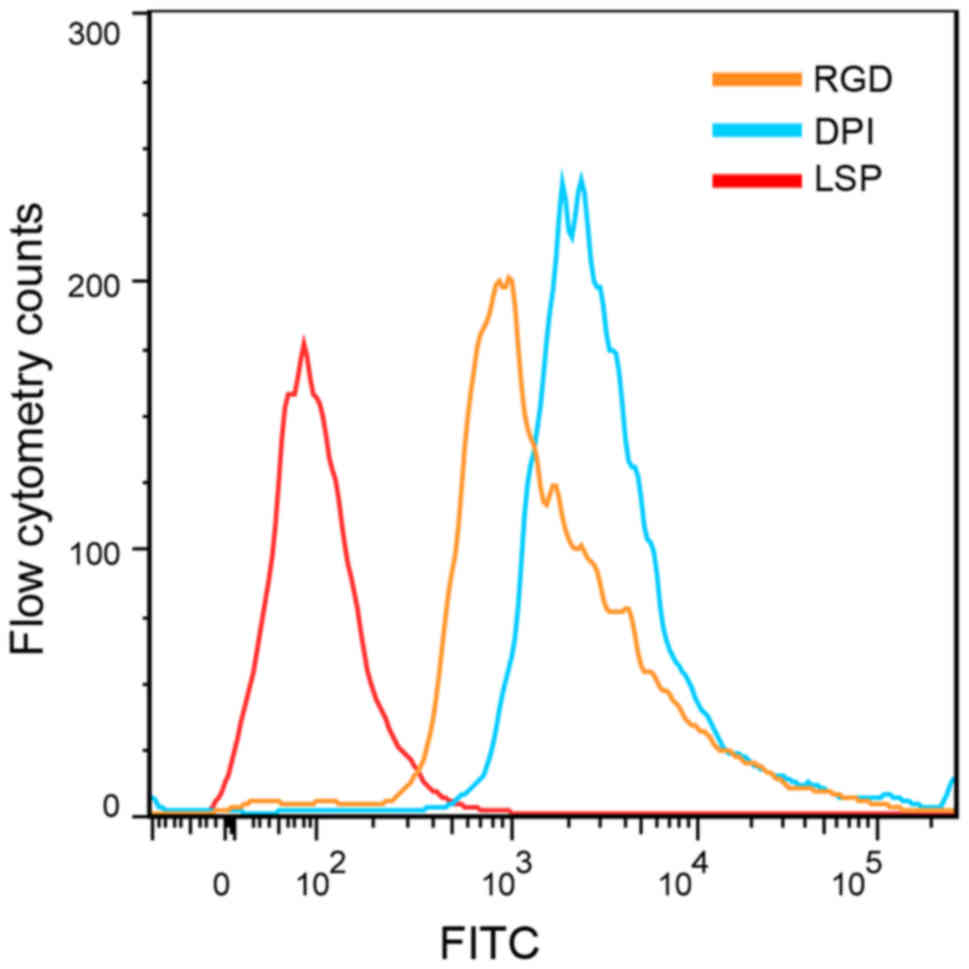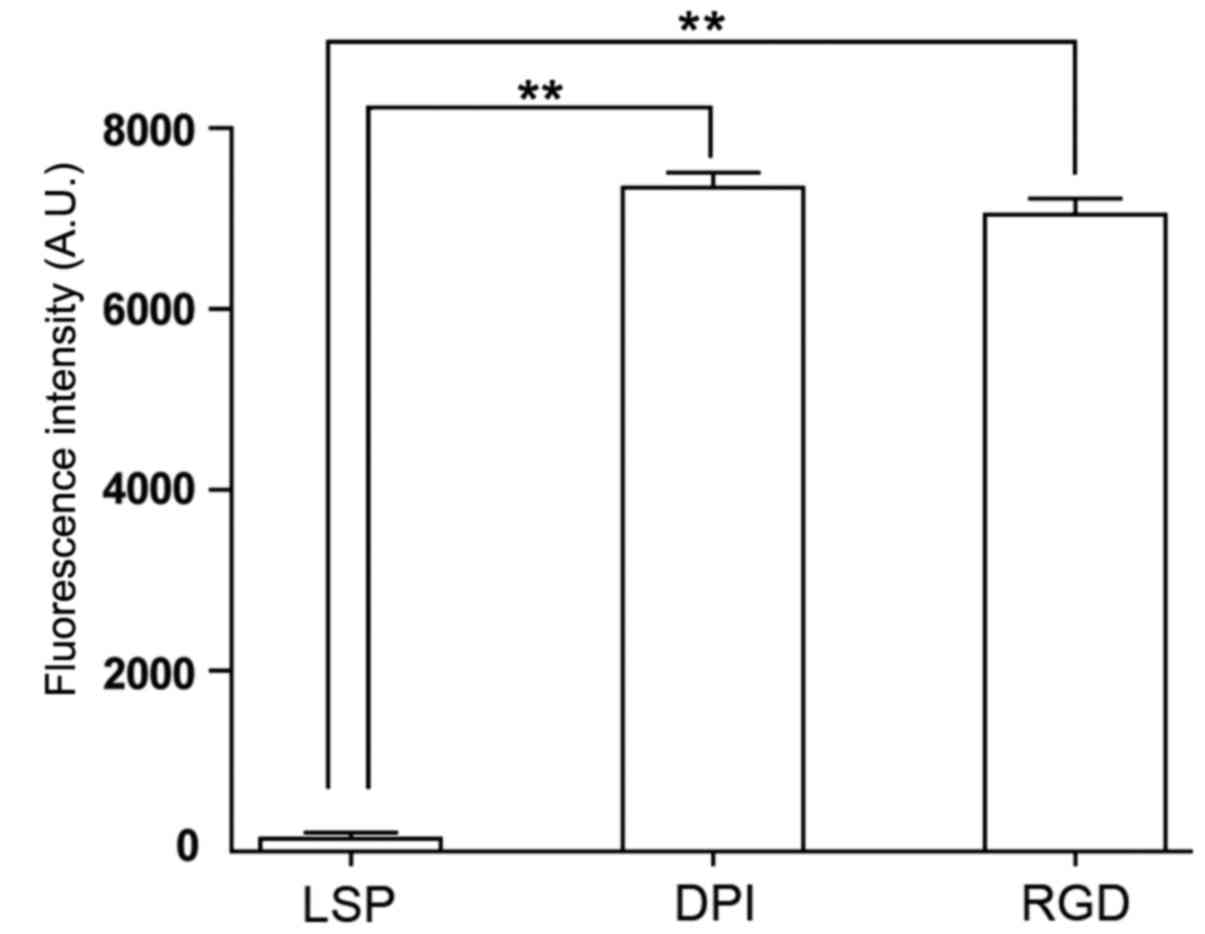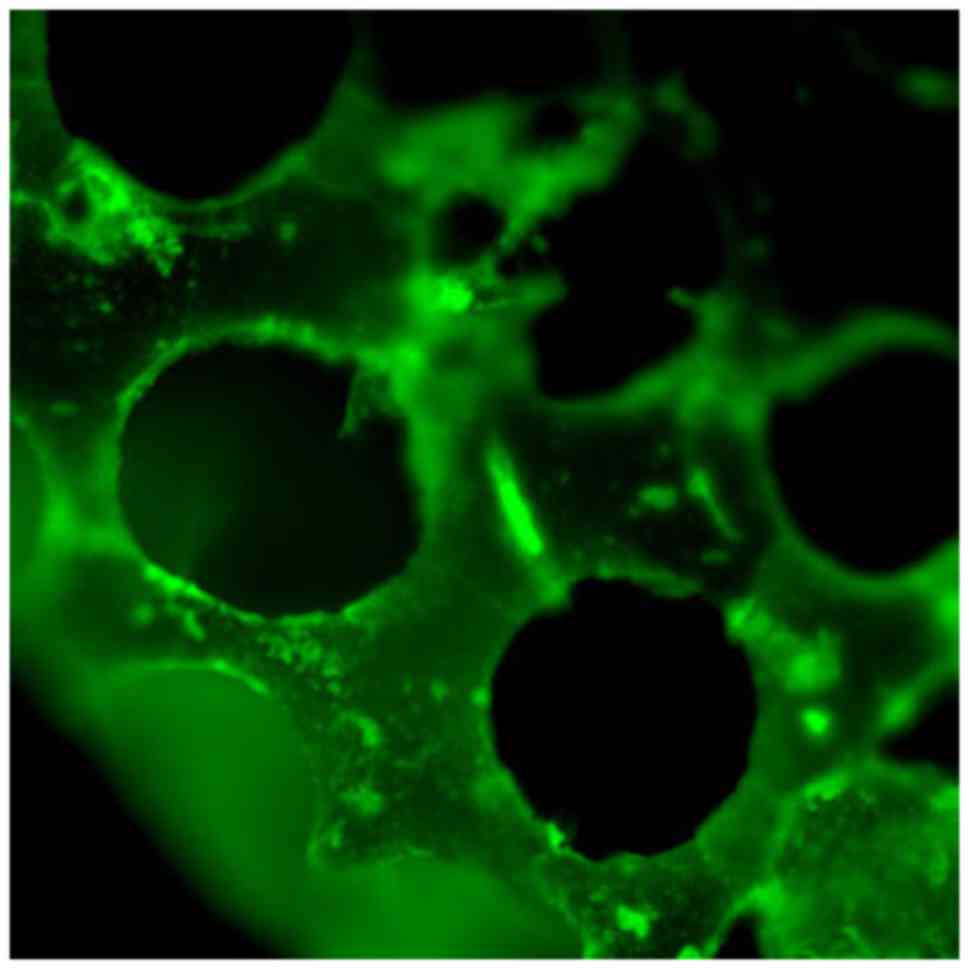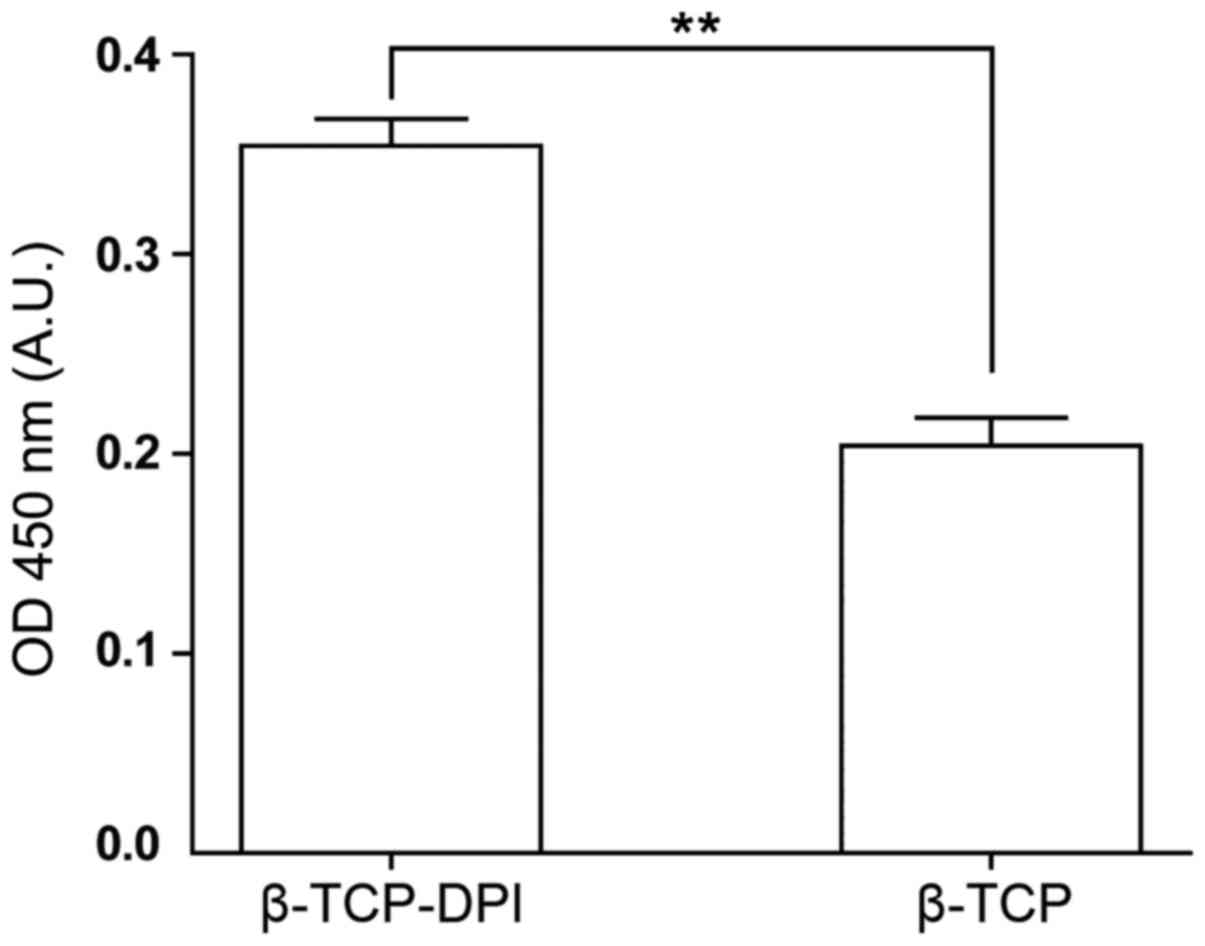|
1
|
Mont MA, Cherian JJ, Sierra RJ, Jones LC
and Lieberman JR: Nontraumatic osteonecrosis of the femoral head:
Where do we stand today? A ten-year update. J Bone Joint Surg Am.
97:1604–1627. 2015. View Article : Google Scholar : PubMed/NCBI
|
|
2
|
Tatara AM and Mikos AG: Tissue engineering
in orthopaedics. J Bone Joint Surg Am. 98:1132–1139. 2016.
View Article : Google Scholar : PubMed/NCBI
|
|
3
|
Ke D, Dernell W, Bandyopadhyay A and Bose
S: Doped tricalcium phosphate scaffolds by thermal decomposition of
naphthalene: Mechanical properties and in vivo osteogenesis in a
rabbit femur model. J Biomed Mater Res B Appl Biomater.
103:1549–1559. 2015. View Article : Google Scholar : PubMed/NCBI
|
|
4
|
LeGeros RZ: Properties of osteoconductive
biomaterials: Calcium phosphates. Clin Orthop Relat Res. 81–98.
2002. View Article : Google Scholar : PubMed/NCBI
|
|
5
|
Pittenger MF, Mackay AM, Beck SC, Jaiswal
RK, Douglas R, Mosca JD, Moorman MA, Simonetti DW, Craig S and
Marshak DR: Multilineage potential of adult human mesenchymal stem
cells. Science. 284:143–147. 1999. View Article : Google Scholar : PubMed/NCBI
|
|
6
|
Li Q, Xing D, Ma L and Gao C: Synthesis of
E7 peptide-modified biodegradable polyester with the improving
affinity to mesenchymal stem cells. Mater Sci Eng C Mater Biol
Appl. 73:562–568. 2017. View Article : Google Scholar : PubMed/NCBI
|
|
7
|
Herrmann M, Verrier S and Alini M:
Strategies to stimulate mobilization and homing of endogenous stem
and progenitor cells for bone tissue repair. Front Bioeng
Biotechnol. 3:792015. View Article : Google Scholar : PubMed/NCBI
|
|
8
|
Shao ZX, Zhang X, Pi YB, Yin L, Li L, Chen
H, Zhou C and Ao Y: Surface modification on polycaprolactone
electrospun mesh and human decalcified bone scaffold with
synovium-derived mesenchymal stem cells-affinity peptide for tissue
engineering. J Biomed Mater Res A. 103:318–329. 2015. View Article : Google Scholar : PubMed/NCBI
|
|
9
|
Pi Y, Zhang X, Shi J, Zhu J, Chen W, Zhang
C, Gao W, Zhou C and Ao Y: Targeted delivery of non-viral vectors
to cartilage in vivo using a chondrocyte-homing peptide identified
by phage display. Biomaterials. 32:6324–6332. 2011. View Article : Google Scholar : PubMed/NCBI
|
|
10
|
Qian JJ and Bhatnagar RS: Enhanced cell
attachment to anorganic bone mineral in the presence of a synthetic
peptide related to collagen. J Biomed Mater Res. 31:545–554. 1996.
View Article : Google Scholar : PubMed/NCBI
|
|
11
|
Bhatnagar RS, Qian JJ and Gough CA: The
role in cell binding of a beta-bend within the triple helical
region in collagen alpha 1 (I) chain: Structural and biological
evidence for conformational tautomerism on fiber surface. J Biomol
Struct Dyn. 14:547–560. 1997. View Article : Google Scholar : PubMed/NCBI
|
|
12
|
Pierschbacher MD and Ruoslahti E: Cell
attachment activity of fibronectin can be duplicated by small
synthetic fragments of the molecule. Nature. 309:30–33. 1984.
View Article : Google Scholar : PubMed/NCBI
|
|
13
|
Hersel U, Dahmen C and Kessler H: RGD
modified polymers: Biomaterials for stimulated cell adhesion and
beyond. Biomaterials. 24:4385–4415. 2003. View Article : Google Scholar : PubMed/NCBI
|
|
14
|
Zhang H and Hollister S: Comparison of
bone marrow stromal cell behaviors on poly (caprolactone) with or
without surface modification: Studies on cell adhesion, survival
and proliferation. J Biomater Sci Polym Ed. 20:1975–1993. 2009.
View Article : Google Scholar : PubMed/NCBI
|
|
15
|
Ramaraju H, Miller SJ and Kohn DH:
Dual-functioning peptides discovered by phage display increase the
magnitude and specificity of BMSC attachment to mineralized
biomaterials. Biomaterials. 134:1–12. 2017. View Article : Google Scholar : PubMed/NCBI
|
|
16
|
Bhatnagar RS, Qian JJ, Wedrychowska A,
Sadeghi M, Wu YM and Smith N: Design of biomimetic habitats for
tissue engineering with P-15, a synthetic peptide analogue of
collagen. Tissue Eng. 5:53–65. 1999. View Article : Google Scholar : PubMed/NCBI
|
|
17
|
Zhang HX, Zhang XP, Xiao GY, Hou Y, Cheng
L, Si M, Wang SS, Li YH and Nie L: In vitro and in vivo evaluation
of calcium phosphate composite scaffolds containing BMP-VEGF loaded
PLGA microspheres for the treatment of avascular necrosis of the
femoral head. Mater Sci Eng C Mater Biol Appl. 60:298–307. 2016.
View Article : Google Scholar : PubMed/NCBI
|
|
18
|
Langer R and Vacanti JP: Tissue
engineering. Science. 260:920–926. 1993. View Article : Google Scholar : PubMed/NCBI
|
|
19
|
Maijenburg MW, van der Schoot CE and
Voemans C: Mesenchymal stromal cell migration: Possibilities to
improve cellular therapy. Stem Cells Dev. 21:19–29. 2012.
View Article : Google Scholar : PubMed/NCBI
|
|
20
|
Caplan AI: New era of cell-based
orthopedic therapies. Tissue Eng Part B Rev. 15:195–200. 2009.
View Article : Google Scholar : PubMed/NCBI
|
|
21
|
Caplan AI: Why are MSCs therapeutic? New
data: New insight. J Pathol. 217:318–324. 2009. View Article : Google Scholar : PubMed/NCBI
|
|
22
|
Zhang H, Lin CY and Hollister SJ: The
interaction between bone marrow stromal cells and RGD-modified
three-dimensional porous polycaprolactone scaffolds. Biomaterials.
30:4063–4069. 2009. View Article : Google Scholar : PubMed/NCBI
|
|
23
|
Shao Z, Zhang X, Pi Y, Wang X, Jia Z, Zhu
J, Dai L, Chen W, Yin L, Chen H, et al: Polycaprolactone
electrospun mesh conjugated with an MSC affinity peptide for MSC
homing in vivo. Biomaterials. 33:3375–3387. 2012. View Article : Google Scholar : PubMed/NCBI
|
|
24
|
Meng Q, Man Z, Dai L, Huang H, Zhang X, Hu
X, Shao Z, Zhu J, Zhang J, Fu X, et al: A composite scaffold of MSC
affinity peptide-modified demineralized bone matrix particles and
chitosan hydrogel for cartilage regeneration. Sci Rep. 5:178022015.
View Article : Google Scholar : PubMed/NCBI
|
|
25
|
Huang H, Zhang X, Hu X, Shao Z, Zhu J, Dai
L, Man Z, Yuan L, Chen H, Zhou C and Ao Y: A functional biphasic
biomaterial homing mesenchymal stem cells for in vivo cartilage
regeneration. Biomaterials. 35:9608–9619. 2014. View Article : Google Scholar : PubMed/NCBI
|
|
26
|
Man Z, Yin L, Shao Z, Zhang X, Hu X, Zhu
J, Dai L, Huang H, Yuan L, Zhou C, et al: The effects of
co-delivery of BMSC-affinity peptide and rhTGF-β1 from coaxial
electrospun scaffolds on chondrogenic differentiation.
Biomaterials. 35:5250–5260. 2014. View Article : Google Scholar : PubMed/NCBI
|
|
27
|
Liu B and Lun DX: Current application of
β-tricalcium phosphate composites in orthopaedics. Orthop Surg.
4:139–144. 2012. View Article : Google Scholar : PubMed/NCBI
|
|
28
|
Rh Owen G, Dard M and Larjava H:
Hydoxyapatite/beta-tricalcium phosphate biphasic ceramics as
regenerative material for the repair of complex bone defects. J
Biomed Mater Res B Appl Biomater. 106:2493–2512. 2018. View Article : Google Scholar : PubMed/NCBI
|
|
29
|
Alvarez LM, Rivera JJ, Stockdale L, Saini
S, Lee RT and Griffith LG: Tethering of epidermal growth factor
(EGF) to beta tricalcium phosphate (βTCP) via fusion to a high
affinity, multimeric βTCP-binding peptide: Effects on human
multipotent stromal cells/connective tissue progenitors. PLoS One.
10:e01296002015. View Article : Google Scholar : PubMed/NCBI
|
|
30
|
Moreno EC, Kresak M and Hay DI: Adsorption
of molecules of biological interest onto hydroxyapatite. Calcif
Tissue Int. 36:48–59. 1984. View Article : Google Scholar : PubMed/NCBI
|
|
31
|
Hay DI and Moreno EC: Differential
adsorption and chemical affinities of proteins for apatitic
surfaces. J Dent Res. 58:930–942. 1979. View Article : Google Scholar : PubMed/NCBI
|
|
32
|
Gorbunoff MJ and Timasheff SN: The
interaction of proteins with hydroxyapatite. III. Mechanism. Anal
Biochem. 136:440–445. 1984. View Article : Google Scholar : PubMed/NCBI
|
|
33
|
Yang XB, Bhatnagar RS, Li S and Oreffo RO:
Biomimetic collagen scaffolds for human bone cell growth and
differentiation. Tissue Eng. 10:1148–1159. 2004. View Article : Google Scholar : PubMed/NCBI
|
|
34
|
Parrish B, Breitenkamp RB and Emrick T:
PEG- and peptide-grafted aliphatic polyesters by click chemistry. J
Am Chem Soc. 127:7404–7410. 2005. View Article : Google Scholar : PubMed/NCBI
|




